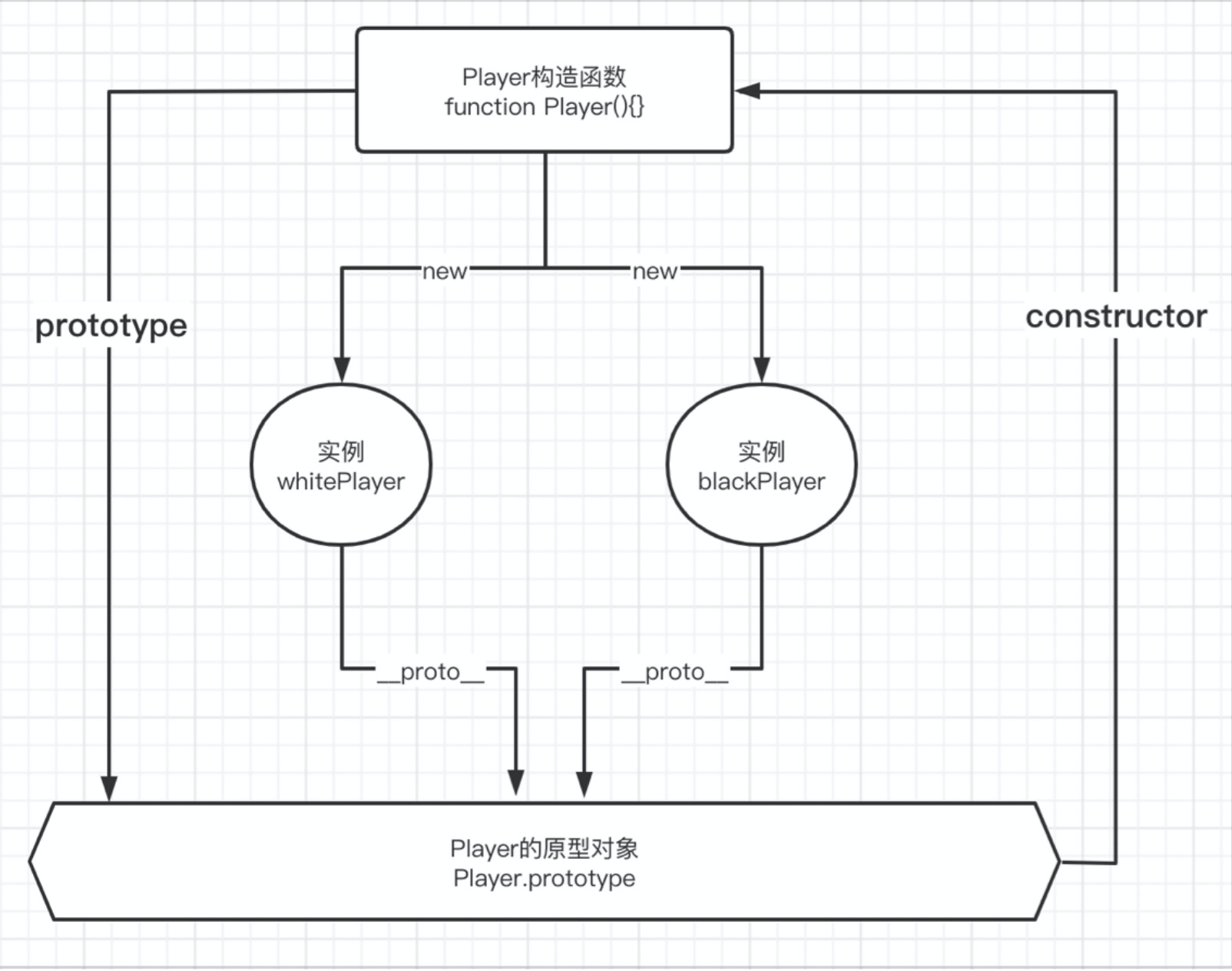- Published on
【笔记】- 原型链与继承
- Authors

- Name
- McDaddy(戣蓦)
创造对象的方式
每次创造一个新空对象,然后往里面加属性,或者利用工厂。这种方式的问题是最后得到的对象没法判断它的类型,得到的类型永远是Object
const Player = new Object(); Player.color = "white"; Player.start = function () { console.log("white下棋"); }; // 工厂 function createObject() { const Player = new Object(); Player.color = "white"; Player.start = function () { console.log("white下棋"); }; return Player; }构造函数/实例
通过 this 添加的属性和⽅法总是指向当前对象的,所以在实例化的时候,通过 this 添加的属性和⽅法都会在内存中复制⼀份,这样就会造成内存的浪费。好处是对象间是隔离的,不会因为修改属性互相影响
function Player(color) { this.color = color; this.start = function () { console.log(color + "下棋"); }; } const whitePlayer = new Player("white"); const blackPlayer = new Player("black");原型
好处是只在内存中创建⼀次,实例化的对象都会指向这个 prototype 对象。
function Player(color) { this.color = color; } Player.prototype.start = function () { console.log(color + "下棋"); }; const whitePlayer = new Player("white"); const blackPlayer = new Player("black");
## 原型及原型链
原型prototype就是一个对象所以可以一次赋值
```javascript
Player.prototype = {
start: function () {
console.log("下棋");
},
revert: function () {
console.log("悔棋");
},
};
如何获取原型
function Player(color) {
this.color = color; }
Player.prototype.start = function () {
console.log(color + "下棋");
};
const whitePlayer = new Player("white");
const blackPlayer = new Player("black");
console.log(blackPlayer.__proto__); // Player {}
console.log(Object.getPrototypeOf(blackPlayer)); // Player {},可以通过
Object.getPrototypeOf来获取__proto__
console.log(Player.prototype); // Player {}
console.log(Player.__proto__); // [Function]
原型链的流程图

new 关键字
new的主要步骤, 假设要实现 new Player()
- 创建一个空对象
- 新对象的__proto__指向Player的prototype
- 执行构造函数,将this指向新对象
- 如果构造函数没有显示返回则返回this 如果构造函数有显示返回,但返回的类型是基本类型如string、number等,那还是返回this 如果构造函数返回的是一个对象,那就返回这个对象
手写一个new
function objectFactory() {
let obj = new Object(); // 1. 创建一个空对象
let Constructor = [].shift.call(arguments); // 取出第一个参数,也就是构造函数,同时arguments也被移除了一位
obj.__proto__ = Constructor.prototype; // 2. 新对象的__proto__指向Player的prototype
let ret = Constructor.apply(obj, arguments); // 执行构造函数,把obj通过apply绑定到构造函数中,如果构造函数中有类似this.xx = xx的情况,这个this就是obj
return typeof ret === "object" ? ret : obj; // 如果ret对象就返回ret,否则返回obj
}
继承
原型链继承
function Parent() {
this.name = "parentName";
this.obj = { a: 1 };
}
Parent.prototype.getName = function () {
console.log(this.name);
};
function Child() {}
// Parent的实例同时包含实例属性⽅法和原型属性⽅法,所以把new Parent()赋值给Child.prototype。
// 如果仅仅Child.prototype = Parent.prototype,那么Child只能调⽤getName,⽆法调⽤.name
// 当Child.prototype = new Parent()后, 如果new Child()得到⼀个实例对象child,那么
// child.__proto__ === Child.prototype;
// Child.prototype.__proto__ === Parent.prototype
// 也就意味着在访问child对象的属性时,如果在child上找不到,就会去Child.prototype去找,如果还找不到,就会去Parent.prototype中去找,从⽽实现了继承。
Child.prototype = new Parent();
// 因为constructor属性是包含在prototype⾥的,上⾯重新赋值了prototype,所以会导致Child的constructor指向[Function: Parent],有的时候使⽤child1.constructor判断类型的时候就会出问题
// 为了保证类型正确,我们需要将Child.prototype.constructor 指向他原本的构造函数Child
Child.prototype.constructor = Child;
var child1 = new Child();
child1.getName(); // parentName
// 问题:
// 1. 如果Parent的属性是对象属性,那么所有的child的原型都指向同一个new Parent(),如果某个child改了obj,那么其他child也会被影响
// 2. 创建child无法给Parent传参
构造函数继承
为了解决上面的问题1,思路就是如何把可能通用的属性在各个子上都复制一遍
function Parent(name, actions) {
this.actions = actions;
this.name = name;
this.eat = function () {}
}
function Child(id, name, actions) {
Parent.call(this, name); // 如果想直接传多个参数, 可以Parent.apply(this, Array.from(arguments).slice(1));
this.id = id;
}
const child1 = new Child(1, "c1", ["eat"]);
const child2 = new Child(2, "c2", ["sing", "jump", "rap"]);
console.log(child1.name); // { actions: [ 'eat' ], name: 'c1', id: 1 }
console.log(child2.name); // { actions: [ 'sing', 'jump', 'rap' ], name: 'c2', id: 2 }
缺点: Parent的方法必须定义在父的构造函数中,每次new Child都要额外为方法开辟一块内存,但事实上方法是不需要对象间隔离的
组合继承
function Parent(name, actions) {
this.name = name;
this.actions = actions;
}
Parent.prototype.eat = function () {
console.log(`${this.name} - eat`);
};
function Child(id) {
Parent.apply(this, Array.from(arguments).slice(1));
this.id = id;
}
Child.prototype = new Parent();
Child.prototype.constructor = Child;
const child1 = new Child(1, "c1", ["hahahahahhah"]);
const child2 = new Child(2, "c2", ["xixixixixixx"]);
child1.eat(); // c1 - eat
child2.eat(); // c2 - eat
console.log(child1.eat === child2.eat); // true
问题: 调用了两次构造函数,apply一次,new Parent一次
寄⽣组合式继承
为了解决上面的问题,很明显apply是没法省的,因为要复制属性,那么回到原型链继承的实现,使用new Parent()是为了让child拿到属性,但现在属性已经由apply构造函数继承包了,所以可以直接用Child.prototype = Parent.prototype。但是这样的话修改直接Child.prototype也会改了Parent,所以用一个Object.create包一层。
Child.prototype = Object.create(Parent);
Child.prototype.constructor = Child;
// 模拟一个Object.create
// 本质就是把一个空方法的prototype指向Parent,然后new这个空方法
let TempFunction = function () {};
TempFunction.prototype = Parent.prototype;
Child.prototype = new TempFunction();